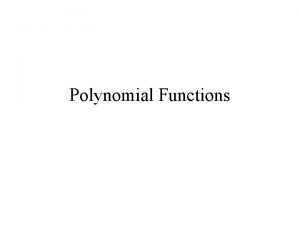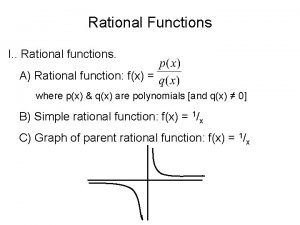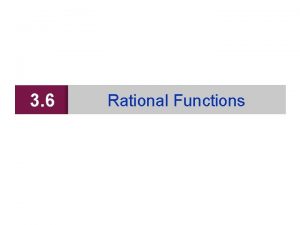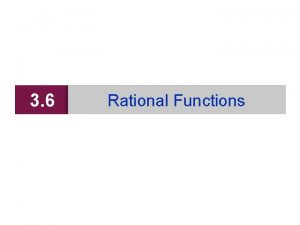2 Polynomial and Rational Functions Copyright Cengage Learning




































- Slides: 36

2 Polynomial and Rational Functions Copyright © Cengage Learning. All rights reserved.

2. 2 Polynomial Functions of Higher Degree Copyright © Cengage Learning. All rights reserved.

What You Should Learn • Use transformations to sketch graphs of polynomial functions. • Use the Leading Coefficient Test to determine the end behavior of graphs of polynomial functions. • Find and use zeros of polynomial functions as sketching aids. • Use the Intermediate Value Theorem to help locate zeros of polynomial functions. 3

Graphs of Polynomial Functions 4

Graphs of Polynomial Functions At this point, you should be able to sketch accurate graphs of polynomial functions of degrees 0, 1, and 2. Function f (x) = ax + b f (x) = ax 2 + b + c Graph Horizontal line Line of slope a Parabola The graphs of polynomial functions of degree greater than 2 are more difficult to sketch by hand. However, in this section you will learn how to recognize some of the basic features of the graphs of polynomial functions. 5

Graphs of Polynomial Functions Using these features along with point plotting, intercepts, and symmetry, you should be able to make reasonably accurate sketches by hand. The graph of a polynomial function is continuous. Essentially, this means that the graph of a polynomial function has no breaks, holes, or gaps, as shown in Figure 2. 7. (a) Polynomial functions have continuous graphs. (b) Functions with graphs that are not continuous are not polynomial functions. Figure 2. 7 6

Graphs of Polynomial Functions Informally, you can say that a function is continuous when its graph can be drawn with a pencil without lifting the pencil from the paper. Another feature of the graph of a polynomial function is that it has only smooth, rounded turns, as shown in Figure 2. 8(a). (a) Polynomial functions have graphs with smooth, rounded turns. Figure 2. 8 7

Graphs of Polynomial Functions It cannot have a sharp turn such as the one shown in Figure 2. 8(b). (b) Functions with graphs that have sharp turns are not polynomial functions. Figure 2. 8 The graphs of polynomial functions of degree 1 are lines, and those of functions of degree 2 are parabolas. 8

Graphs of Polynomial Functions The graphs of all polynomial functions are smooth and continuous. A polynomial function of degree n has the form f (x) = anxn + an – 1 xn – 1 + …… + a 2 x 2 + a 1 x + a 0 where n is a positive integer and an 0. The polynomial functions that have the simplest graphs are monomials of the form f (x) = xn, where n is an integer greater than zero. The greater the value of n, the flatter the graph near the origin. 9

Graphs of Polynomial Functions When n is even, the graph is similar to the graph of f (x) = x 2 and touches the x-axis at the x-intercept. When n is odd, the graph is similar to the graph of f (x) = x 3 and crosses the x-axis at the x-intercept. Polynomial functions of the form f (x) = xn are often referred to as power functions. 10

Example 1 – Library of Parent Functions: f (x) = x 3 Sketch the graphs of (a) g (x) = –x 3 (b) h (x) = x 3 + 1 (c) k (x) = (x – 1)3. 11

Example 1(a) – Solution With respect to the graph of f (x) = x 3, the graph of g is obtained by a reflection in the x-axis, as shown in Figure 2. 9 12

Example 1(b) – Solution cont’d With respect to the graph of f (x) = x 3, the graph of h is obtained by a vertical shift one unit upward, as shown in Figure 2. 10 13

Example 1(c) – Solution cont’d With respect to the graph of f (x) = x 3, the graph of k is obtained by a horizontal shift one unit to the right, as shown in Figure 2. 11 14

The Leading Coefficient Test 15

The Leading Coefficient Test In Example 1, note that all three graphs eventually rise or fall without bound (this means it goes to positive infinity on the right) as x moves to the right. Whether the graph of a polynomial eventually rises or falls can be determined by the polynomial function’s degree (even or odd) and by its leading coefficient, as indicated in the Leading Coefficient Test. 16

The Leading Coefficient Test 17

The Leading Coefficient Test 18

Example 2 – Applying the Leading Coefficient Test Use the Leading Coefficient Test to describe the right-hand left-hand behavior of the graph of f (x) = –x 3 + 4 x. 19

Example 2 – Solution Because the degree is odd and the leading coefficient is negative, the graph rises to the left and falls to the right, as shown in Figure 2. 12 20

Zeros of Polynomial Functions 21

Zeros of Polynomial Functions It can be shown that for a polynomial function f of degree n, the following statements are true. 1. The function f has at most n real zeros. 2. The graph of f has at most n – 1 relative extrema (relative minima or maxima). Recall that a zero of a function f is a number x for which f (x) = 0. We also call zeros x-intercepts or roots. 22

Zeros of Polynomial Functions 23

Example 4 – Finding Zeros of a Polynomial Function Find all real zeros of f (x) = x 3 – x 2 – 2 x. Solution: f (x) = x 3 – x 2 – 2 x. Write original function. 0 = x 3 – x 2 – 2 x Substitute 0 for f (x). 0 = x(x 2 – x – 2) Remove common monomial factor. 0 = x(x – 2)(x + 1) Factor completely and do the zero product property. 24

Example 4 – Solution cont’d So, the real zeros are x = 0, x = 2, and x = – 1 and the corresponding x-intercepts are (0, 0), (2, 0), and (– 1, 0). Check (0)3 – (0)2 – 2(0) = 0 x = 0 is a zero. (2)3 – (2)2 – 2(2) = 0 x = 2 is a zero. (– 1)3 – (– 1)2 – 2(– 1) = 0 x = – 1 is a zero. 25

Zeros of Polynomial Functions 26

Example 8 – Sketching the Graph of a Polynomial Function Sketch the graph of f (x) = 3 x 4 – 4 x 3 by hand. 27

Example 8 – Solution 1. Apply the Leading Coefficient Test. Because the leading coefficient is positive and the degree is even, you know that the graph eventually rises to the left and to the right (see Figure 2. 18). Figure 2. 18 28

Example 8 – Solution cont’d 2. Find the Real Zeros of the Polynomial by factoring and setting each factor equal to zero separately: f (x) = 3 x 4 – 4 x 3 = x 3(3 x – 4) 0 = x 3 0 = 3 x - 4 you can see that the real zeros of f are x = 0 (of odd multiplicity 3 ) and x = (of odd multiplicity 1). So, the x-intercepts occur at (0, 0) and ( , 0). Add these points to your graph, as shown in Figure 2. 18. 29

Example 8 – Solution cont’d 3. Plot a Few Additional Points. To sketch the graph by hand, find a few additional points, as shown in the table. Be sure to choose points between the zeros and to the left and right of the zeros. Figure 2. 19 30

The Intermediate Value Theorem 31

The Intermediate Value Theorem concerns the existence of real zeros of polynomial functions. The theorem states that if (a, f (a)) and (b, f (b)) are two points on the graph of a polynomial function such that f (a) f (b), then for any number d between f (a) and f (b) there must be a number c between a and b such that f (c) = d. 32

The Intermediate Value Theorem (See Figure 2. 22. ) Figure 2. 22 33

The Intermediate Value Theorem 34

Example 10 – Approximating the Zeros of a Function Find three intervals of length 1 in which the polynomial f (x) = 12 x 3 – 32 x 2 + 3 x + 5 is guaranteed to have a zero. Solution: From the table in Figure 2. 24, you can see that f (– 1) and f (0) differ in sign. Figure 2. 24 35

Example 10 – Solution cont’d So, you can conclude from the Intermediate Value Theorem that the function has a zero between – 1 and 0. Similarly, f (0) and f (1) differ in sign, so the function has a zero between 0 and 1. Likewise, f (2) and f (3) differ in sign, so the function has a zero between 2 and 3. So, you can conclude that the function has zeros in the intervals (– 1, 0), (0, 1), and (2, 3). 36
 Copyright cengage learning. powered by cognero
Copyright cengage learning. powered by cognero Chapter 4 polynomial and rational functions
Chapter 4 polynomial and rational functions Chapter 3 polynomial and rational functions
Chapter 3 polynomial and rational functions Chapter 3 polynomial and rational functions
Chapter 3 polynomial and rational functions 2009 delmar cengage learning
2009 delmar cengage learning Cengage learning heart diagram
Cengage learning heart diagram Cengage learning heart diagram
Cengage learning heart diagram South-western cengage learning
South-western cengage learning Chapter 13 medical math assignment sheet
Chapter 13 medical math assignment sheet 2009 delmar cengage learning
2009 delmar cengage learning Cengage learning heart diagram
Cengage learning heart diagram Introduction to medical terminology chapter 1 answer key
Introduction to medical terminology chapter 1 answer key Cengage learning australia
Cengage learning australia Measuring and recording apical pulse
Measuring and recording apical pulse Cengage learning
Cengage learning Cengage learning
Cengage learning Wadsworth cengage learning
Wadsworth cengage learning Cengage learning
Cengage learning Cengage learning plant cell
Cengage learning plant cell Cengage learning
Cengage learning Cengage learning
Cengage learning Brooks cole cengage learning
Brooks cole cengage learning The human respiratory system chapter 7 handout
The human respiratory system chapter 7 handout 2014 cengage learning accounting answers
2014 cengage learning accounting answers Cengage learning
Cengage learning Cengage learning
Cengage learning Chapter 6 the skeletal system answer key
Chapter 6 the skeletal system answer key Cengage learning
Cengage learning 2009 delmar cengage learning
2009 delmar cengage learning Marketing implications
Marketing implications 2012 cengage learning
2012 cengage learning Solomon four group design
Solomon four group design Cengage learning psychology
Cengage learning psychology Course technology cengage learning
Course technology cengage learning Course technology cengage learning
Course technology cengage learning Course technology cengage learning
Course technology cengage learning Course technology cengage learning
Course technology cengage learning




























































